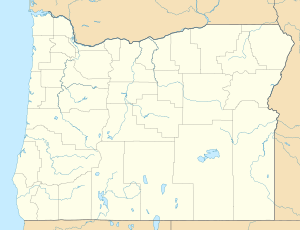Elk Creek (Umpqua River tributary) facts for kids
Quick facts for kids Elk Creek |
|
|---|---|

Map of the Umpqua River watershed
|
|
|
Location of the mouth of Elk Creek in Oregon
|
|
| Country | United States |
| State | Oregon |
| County | Douglas |
| Physical characteristics | |
| Main source | Ben More Mountain near Elkhead, lower Cascade Range 1,245 ft (379 m) 43°30′00″N 123°09′37″W / 43.50000°N 123.16028°W |
| River mouth | Umpqua River Elkton 82 ft (25 m) 43°38′01″N 123°34′02″W / 43.63361°N 123.56722°W |
| Length | 46 mi (74 km) |
| Basin features | |
| Basin size | 290 sq mi (750 km2) |
Elk Creek is a stream in the state of Oregon, USA. It flows for about 46 miles (74 kilometers) before joining the Umpqua River. It's an important part of the local water system in Douglas County.
Elk Creek's Journey
Elk Creek starts near Ben More Mountain in the lower Cascade Range. This is a mountain range in the western part of North America. The creek begins south of a small place called Elkhead.
From there, Elk Creek generally flows north. It passes under Interstate 5, which is a major highway. After that, it makes a sharp turn and heads west. The creek then flows through the small city of Drain.
Finally, Elk Creek meets the Umpqua River at Elkton. Two state roads, Oregon Route 99 and Oregon Route 38, follow parts of the creek's path. Oregon Route 99 runs along it for a short distance south of Drain. Oregon Route 38 follows the creek all the way from Drain to Elkton.
A Bridge from the Past
Once upon a time, there was a special bridge over Elk Creek called the Roaring Camp Bridge. It was a private covered bridge, which means it had walls and a roof. This bridge was located about 6 miles (10 kilometers) west of Drain.
A person named Robert Lancaster built the bridge in 1929. He needed it to get to his farm. The bridge was considered important enough to be added to the National Register of Historic Places in 1979. This is a list of places in the United States that are important to history. However, the bridge was taken off this list in 1995 because it was torn down.
Smaller Streams Joining In
Many smaller streams, called tributaries, flow into Elk Creek along its journey. These smaller creeks add water to Elk Creek, making it bigger as it flows. Some of these named tributaries include Shingle Mill, Walker, Adams, Bennet, Cox, Salt, and Wehmeyer creeks.
Further downstream, you'll find other creeks like Asker, McClintock, Wise, Yoncalla, Pass, Post, and Billy creeks joining in. Closer to where Elk Creek meets the Umpqua River, you'll find even more streams like Hardscrabble, Jack, Parker, Lancaster, Indian, Brush, Big Tom Folley, Hancock, and Little Tom Folley creeks.


